DECOSIS Projector Stand Tripod...
$37.99 (as of July 19, 2024 13:39 GMT +00:00 - More infoProduct prices and availability are accurate as of the date/time indicated and are subject to change. Any price and availability information displayed on [relevant Amazon Site(s), as applicable] at the time of purchase will apply to the purchase of this product.)PQRQP 2 Pack Wireless Lavalier...
$23.99 (as of July 19, 2024 13:39 GMT +00:00 - More infoProduct prices and availability are accurate as of the date/time indicated and are subject to change. Any price and availability information displayed on [relevant Amazon Site(s), as applicable] at the time of purchase will apply to the purchase of this product.)EJCC 2 Pack Wireless Microphon...
$24.99 (as of July 19, 2024 13:39 GMT +00:00 - More infoProduct prices and availability are accurate as of the date/time indicated and are subject to change. Any price and availability information displayed on [relevant Amazon Site(s), as applicable] at the time of purchase will apply to the purchase of this product.)Lenovo IdeaPad 1 Laptop, 15.6” FHD Display, AMD Ryzen 5 5500U, 8GB RAM, 512GB SSD, Windows 11 Home, 720p Camera w/Privacy Shutter, Smart Noise Cancelling, Cloud Grey
$329.99 (as of July 19, 2024 13:39 GMT +00:00 - More infoProduct prices and availability are accurate as of the date/time indicated and are subject to change. Any price and availability information displayed on [relevant Amazon Site(s), as applicable] at the time of purchase will apply to the purchase of this product.)HP 14 inch Laptop, HD Display, 12th Generation Intel Core i3-1215U, 8 GB RAM, 256 GB SSD, Intel UHD Graphics, Windows 11 Home in S mode, 14-dq5009nr (2024)
$349.00 (as of July 19, 2024 13:39 GMT +00:00 - More infoProduct prices and availability are accurate as of the date/time indicated and are subject to change. Any price and availability information displayed on [relevant Amazon Site(s), as applicable] at the time of purchase will apply to the purchase of this product.)Mac Book Pro Charger - 118W USB C Charger Fast Charger Compatible with USB C Port MacBook pro/Air, ipad Pro, Samsung Galaxy and All USB C Device, Include Charge Cable(7.2ft/2.2m)
$35.99 (as of July 19, 2024 13:39 GMT +00:00 - More infoProduct prices and availability are accurate as of the date/time indicated and are subject to change. Any price and availability information displayed on [relevant Amazon Site(s), as applicable] at the time of purchase will apply to the purchase of this product.)Introduction iZotope Nectar 3
Nectar 3 vst Ever since its debut in 2010, Nectar has firmly secured its spot in both casual home recording setups and top-tier studios. Its reputation is built on the ability to deliver professional-grade results in mere seconds. The latest iteration, Nectar 3, takes a bold step forward, integrating iZotope’s revolutionary machine learning, inter-plugin communication, and signal processing technologies. In this feature guide, we’ll delve into these enhancements and more to ensure you make the most of this versatile plugin.
Table of Contents
Nectar 3 VST Overview
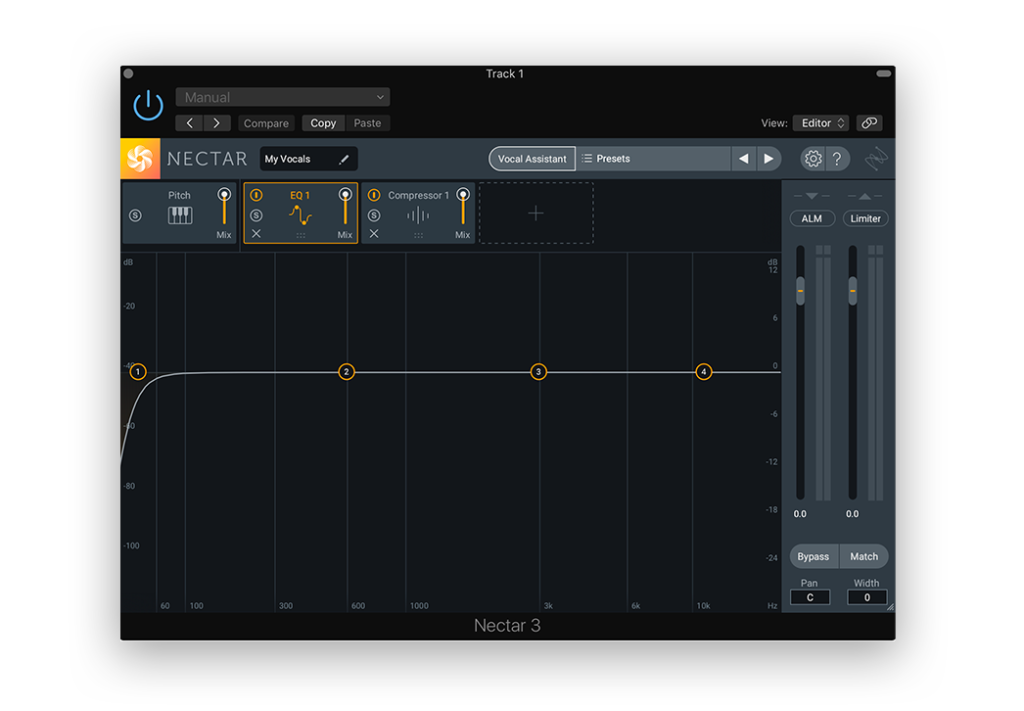
Upon launching Nectar 3, you’re greeted by a default setting featuring three modules – Pitch, EQ 1, and Compressor 1. This serves as a basic starting point, incorporating a high pass at 40 Hz and subtle compression. The modules line up horizontally across the GUI, and their sequence is customizable. Beyond the initial trio, a range of additional modules tailored for vocal processing, such as Delay, De-essing, Dimension, Gate, Harmony, Reverb, and Saturation, can be seamlessly added to your chain. Click on any module to open its unique GUI in the main window.
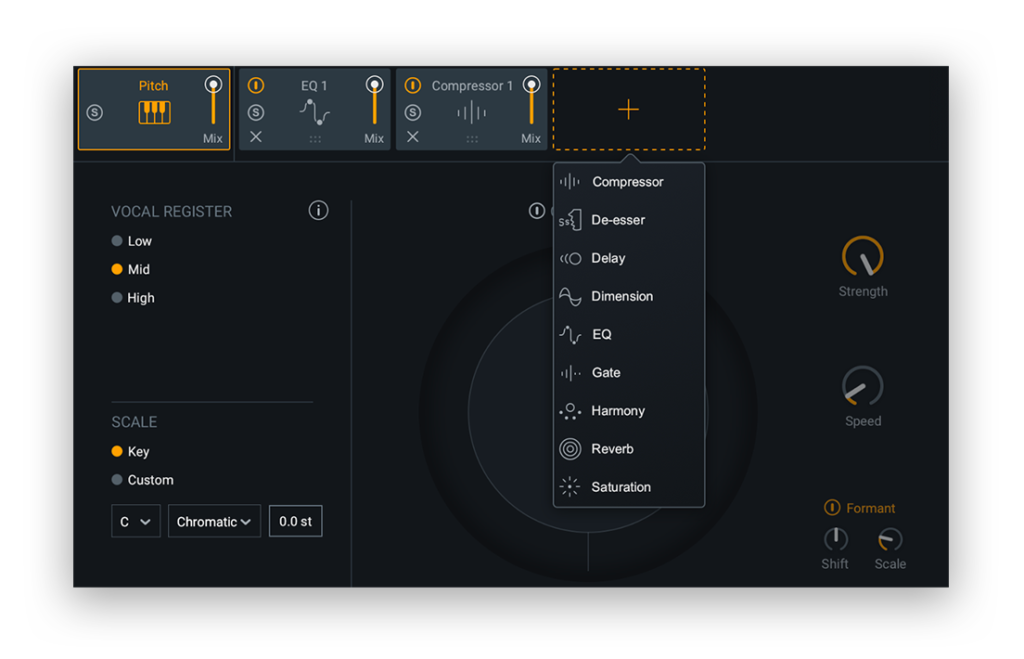
With this array of modules at your disposal, selecting a starting point may seem daunting. Nectar 3 provides refined presets, ranging from practical (Background Noise Removal, Increase Vocal Clarity) to the extravagant (Robo Army, Elephants But On Mars). Alternatively, utilize Vocal Assistant to intelligently generate an optimized starting point for your specific vocal track.
iZotope Nectar 3 Vocal Assistant
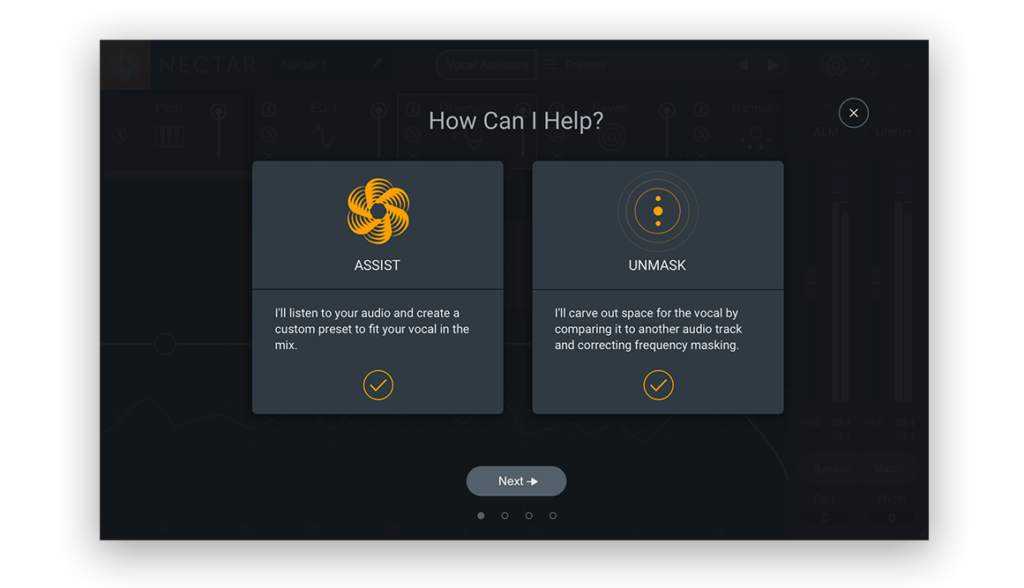
Consider Vocal Assistant your extra pair of trusted ears. It offers two helpful options: Assist and Unmask.
Assist Nectar 3 vst
Powered by machine learning, Vocal Assistant identifies and adjusts level inconsistencies, timbre variations, resonant peaks, and harsh frequencies automatically. It tackles these issues by configuring EQ nodes, eliminating bothersome sibilants, and suggesting compression settings. You can align the overall sound aesthetics with one of three Vibes (Vintage, Modern, or Dialogue) and choose from three Intensities (Light, Moderate, or Aggressive). The Assist feature accelerates the process, allowing you to concentrate on adding your personal touch.

Unmask
Masking, a common mix issue, occurs when the perception of one sound is influenced by another in a shared frequency range, often leading to reduced clarity and a sense of ‘mudiness.’ Nectar 3 introduces Unmask to counteract vocal masking. This feature identifies sources besides your vocal track for comparison—utilizing Relay plugin or Nectar 3 instances in the processing chain of other elements. Attach the Relay plugin or Nectar 3 to the desired tracks, select Unmask in Vocal Assistant, and witness all selected sources directly within Nectar 3.

Choose a track for Unmask to work its magic. If masking is detected, a static EQ is applied to carve out spectral space for the vocal. The Relay plugin, an innovative example of inter-plugin communication, dynamically updates its display.
Pro Tip: Leverage Nectar 3’s integration with other iZotope plugins for a comprehensive production overview, connecting vocals with Neutron 2, Visual Mixer, Masking Meter, Tonal Balance Control, and Insight 2’s Intelligibility Meter.

Dynamic EQs
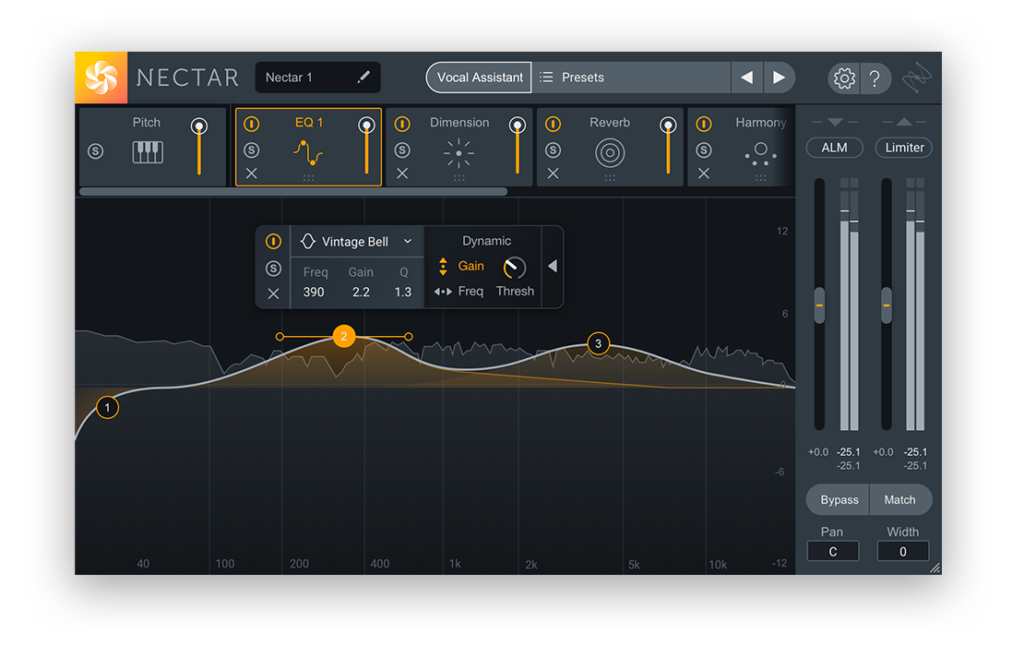
Highlighting Nectar 3’s enhancements are two dynamic frequency modes that adapt intelligently to your vocals: Dynamic Frequency and Dynamic Gain modes. These modes respond to changes in harmonic frequency content and input levels, respectively. Click on a node, or add your own, and explore the Dynamic menu to toggle these features.
Pro Tip #1: Use Dynamic Frequency Mode on a high pass filter to track the first harmonic of a vocal, dynamically eliminating undesirable low-end rumble while preserving character.
Pro Tip #2: Employ Dynamic Frequency Mode on a Bell filter to track and reduce harsh vocal resonances.
Harmony
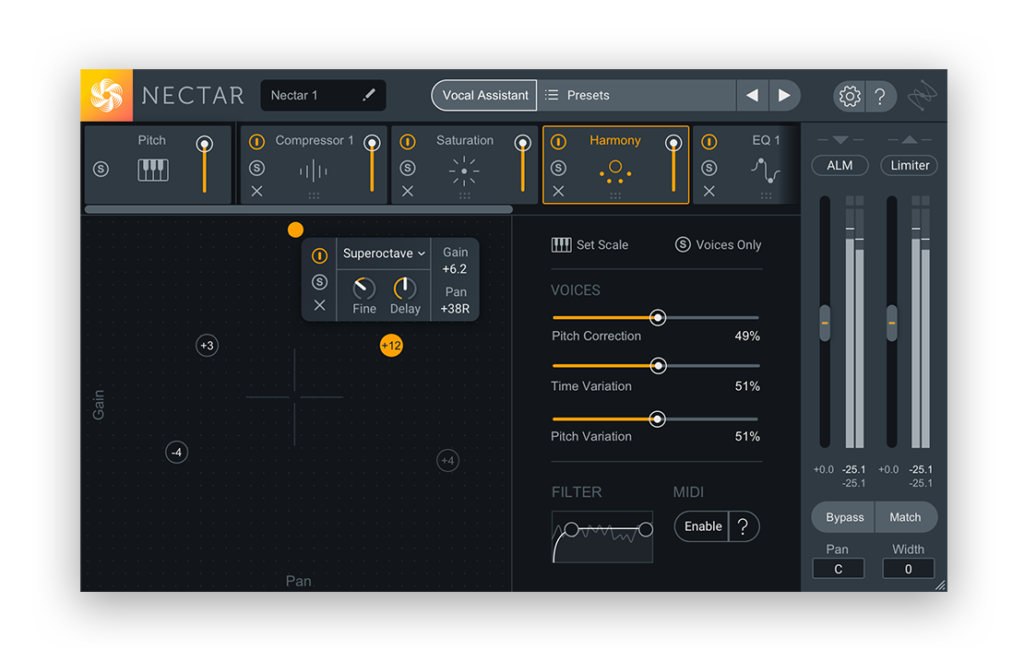
While Vocal Assistant and Dynamic EQs excel at corrective enhancements, the Harmony module adds a creative flair to your vocals. The Voice XY Pad Controller, a grid-like area, provides an intuitive platform for generating vocal harmonies. Click anywhere on the grid to add a new voice, select the interval via the drop-down menu, and set a custom key. The vertical position on the pad controls volume, while the horizontal position determines stereo placement, facilitating an efficient workflow for creating harmonies.
Pro Tip: Activate MIDI mode for precise control over harmonies using a MIDI controller, found in the bottom right of the GUI.
This concludes our introductory tour of Nectar 3, offering a glimpse into its new and improved features. While there are many more modules to explore, we hope this guide serves as a solid starting point. If you have any questions, feel free to leave them in the comments below.
FAQ: iZotope Nectar 3
General Information
Q: What is iZotope Nectar 3?
A: Nectar 3 is a versatile VST plugin designed for vocal processing. It integrates advanced machine learning, inter-plugin communication, and signal processing technologies to deliver professional-grade results quickly.
Q: When was Nectar 3 released?
A: Nectar 3 is the latest iteration of the Nectar series, which debuted in 2010.
Features and Modules
Q: What modules are included in the default setting of Nectar 3?
A: The default setting includes Pitch, EQ 1, and Compressor 1 modules, featuring a high pass at 40 Hz and subtle compression. Additional modules such as Delay, De-essing, Dimension, Gate, Harmony, Reverb, and Saturation can be added.
Q: How can I customize the sequence of modules in Nectar 3?
A: The modules line up horizontally across the GUI, and their sequence can be customized by the user.
Q: What are some of the refined presets available in Nectar 3?
A: Presets range from practical options like Background Noise Removal and Increase Vocal Clarity to more extravagant settings like Robo Army and Elephants But On Mars.
Vocal Assistant
Q: What is the Vocal Assistant in Nectar 3?
A: The Vocal Assistant is a feature that helps optimize your vocal track by offering two options: Assist and Unmask.
Q: How does the Assist feature work?
A: The Assist feature uses machine learning to identify and adjust level inconsistencies, timbre variations, resonant peaks, and harsh frequencies automatically. It provides sound aesthetics options with three Vibes (Vintage, Modern, or Dialogue) and three Intensities (Light, Moderate, or Aggressive).
Unmask Feature
Q: What is the Unmask feature?
A: Unmask identifies and reduces masking, a common mix issue where one sound influences another in a shared frequency range, reducing clarity. It uses the Relay plugin or Nectar 3 instances to compare and process other elements in the mix.
Q: How does Unmask work?
A: Attach the Relay plugin or Nectar 3 to the desired tracks, select Unmask in Vocal Assistant, and choose a track for Unmask to carve out spectral space for the vocal if masking is detected.
Dynamic EQs
Q: What are Dynamic EQs in Nectar 3?
A: Dynamic EQs in Nectar 3 include Dynamic Frequency and Dynamic Gain modes that adapt intelligently to your vocals based on harmonic frequency content and input levels.
Q: How can Dynamic Frequency Mode be used effectively?
A: Use Dynamic Frequency Mode on a high pass filter to dynamically eliminate low-end rumble while preserving character, or on a Bell filter to track and reduce harsh vocal resonances.
Harmony Module
Q: What does the Harmony module do?
A: The Harmony module allows for creative vocal enhancements by generating vocal harmonies using the Voice XY Pad Controller. You can add new voices, select intervals, and set a custom key, with volume and stereo placement controlled via the grid.
Q: Can I control harmonies with a MIDI controller?
A: Yes, you can activate MIDI mode for precise control over harmonies using a MIDI controller, found in the bottom right of the GUI.
Additional Tips
Q: How can I maximize the use of Nectar 3 with other iZotope plugins?
A: Leverage Nectar 3’s integration with other iZotope plugins like Neutron 2, Visual Mixer, Masking Meter, Tonal Balance Control, and Insight 2’s Intelligibility Meter for a comprehensive production overview.
Conclusion
Q: Is this guide exhaustive of all Nectar 3 features?
A: No, this guide covers the primary features and modules of Nectar 3. There are many more modules to explore, and users are encouraged to experiment and ask questions if needed.
Feel free to leave any additional questions in the comments below.
Tips by smmastering.com
- DAVID GUETTA AND ARMIN VAN BUUREN
- Anyma to Make History in Las Vegas
- Waves V15 with StudioVerse
- Moog Spectravox Moog Semi-Modular Line
- The AI Revolution in Music: From Creation to Distribution











